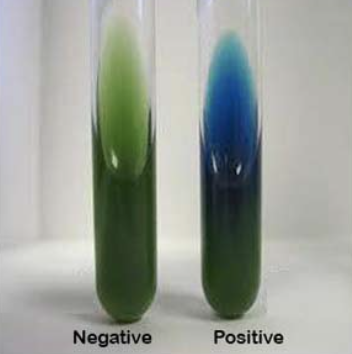What are Biochemical Tests?
Bacteria are fascinating and complex creatures, with a wide range of nutritional preferences and metabolic pathways. Remember, these organisms are so tiny we cannot see them without a microscope; it is difficult to actually see them in action as they break down compounds. Fortunately, we can use various biochemical tests to find out more about our bacteria! The idea behind biochemical tests is that we add a chemical to our bacteria or spread a sample of bacteria on a test tube/petri dish containing a substance. The tube or dish will contain nutrients that a bacteria may use. We observe the test after a certain amount of time, and see if it looks any different. Some things to look for are color change, bubbles, or a clear zone within the plate. These can inform us on what the bacteria uses for energy, any enzymes it secretes(releases) to protect itself, and other attributes!
Some examples of biochemical tests are catalase, Simmons' citrate, and starch hydrolysis.
With the catalase test, we'd like to know if the bacteria produces the enzyme catalase. This enzyme is important because it helps break down hydrogen peroxide (H2O2) - which is dangerous for the cell - into water(H2O) and oxygen(O2) which are much safer. You add 3% H2O2 (hydrogen peroxide) to the bacteria. If it bubbles, then it produces catalase. If it does not bubble, then it does not produce catalase. You would see the results in a matter of seconds.
For the Simmons' citrate test, we're curious if the bacteria can use citrate as the only source of energy. The test looks like a slant(test tube with slanted agar) with a distinctive green color! You would inoculate the tube with your bacteria, and then wait 1-2 days. If the media turns blue, it is positive for citrate use. If it is still green, it is negative-cannot use citrate! The reason for the color change, is that the media contains bromothymol blue, a chemical that turns blue when the pH is above 7.6. If the bacteria can use citrate, it releases byproducts that increase the pH, resulting in the blue color.
For the starch hydrolysis test, we'd like to find out if the bacteria can hydrolyze, or break down starch. You would use a petri dish with agar that contains starch. Place your bacteria on the dish, refrigerate it after 24-28 hours, then come back to it a week after you first inoculated it. Add iodine to the plate. If there is a clear zone around the bacteria, this indicates a positive result- the bacteria produces amylase and is able to break down starch. As starch is a larger molecule, bacteria need to secrete(release) amylase to break it down into smaller parts so it is easier to absorb. If there is no clear zone, the bacteria is negative for starch hydrolysis.
These are only a few examples, there are many more tests available to help us learn more about our microorganisms!
Interpretation of results for the Simmons’ citrate test.
Picture Source: microbiologyinfo.com

